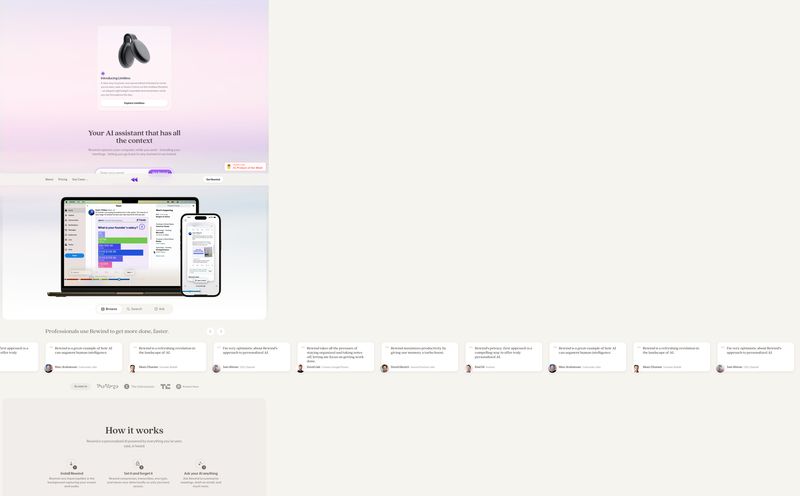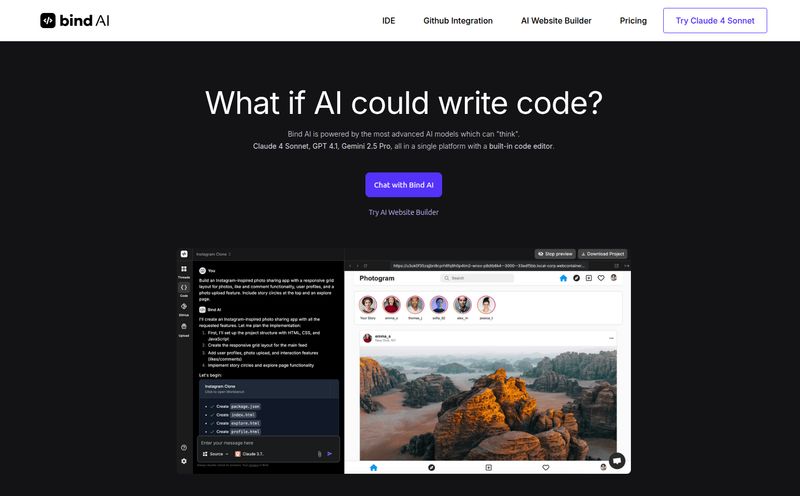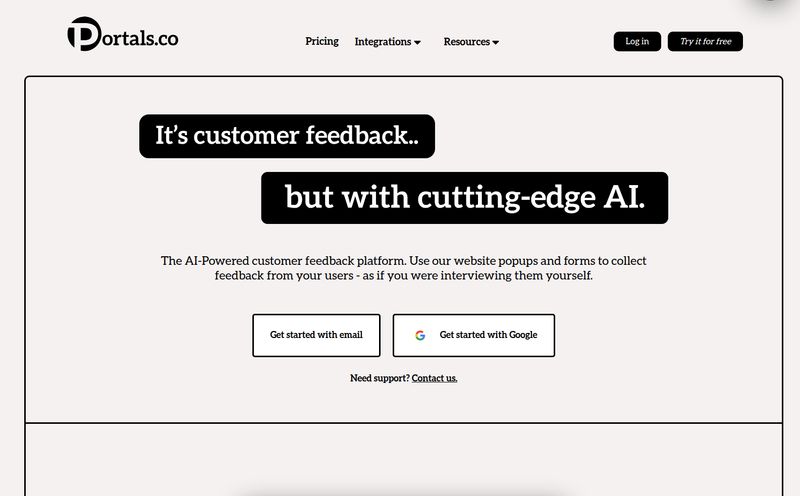For years, I’ve been in the trenches of SEO and digital marketing, and I’ve seen countless apps promise to revolutionize our lives. Especially in the health and fitness space. We've all been there, right? You download the latest, greatest calorie counter with high hopes. For three days, you religiously weigh your chicken breast and scan barcodes. By day five, the thought of manually logging one more almond makes you want to throw your phone into the sea. It's a chore.
The whole process is just… tedious. It’s the single biggest reason people give up on tracking their food intake. So when I see an app like FoodIntake pop up, waving its hands and shouting about “AI-powered food analysis from a photo,” my inner cynic and my inner tech-nerd get into a loud argument. Could this actually be it? The tool that finally makes food logging not just bearable, but maybe even… easy? I had to find out.
What Exactly is FoodIntake? Beyond Just Another Food Diary
Let's get one thing straight: this isn't just another digital spreadsheet for your meals. FoodIntake's entire pitch hangs on a very slick, very 2024 idea: letting artificial intelligence do the heavy lifting. Instead of typing in “one medium apple,” you snap a picture of it. Instead of searching a database for “homemade chicken stir-fry,” you upload a photo of your plate and let the app’s AI try to figure it out.

Visit FoodIntake
The system is designed to analyze that image, cross-reference it with a massive food database, and spit out a comprehensive breakdown of what you’re about to eat. We're talking calories, protein, carbs, fats, even down to the vitamins and minerals. It also takes your personal stats—age, weight, activity level—to calculate your Estimated Energy Requirement (EER) and set personalized macronutrient goals (AMDR). It’s an ambitious concept that tries to bridge the gap between effortless and informative.
My First Impressions and Getting Started
Getting into the app is pretty straightforward. You give it the usual biometric data, which is crucial for the personalization aspect. The interface itself is clean, I’ll give it that. It doesn't feel cluttered with a million buttons and banners like some of the, ahem, veteran apps in this space. It feels modern and focused on its main task: getting your food logged.
The dashboard presents your key numbers clearly. Calories for the day, your macro breakdown, that sort of thing. There’s no steep learning curve, which is a huge plus. You’re immediately directed toward the core functions: log via photo, or log manually. For me, the real test was always going to be that camera button.
The Magic Wand of Food Tracking: Using the Image AI
This is the main event. The feature that makes FoodIntake different from the old guard like MyFitnessPal. I decided to put it through a few real-world tests.
First up, a simple lunch: a grilled chicken salad with avocado, cherry tomatoes, and a light vinaigrette. I snapped a picture. The AI whirred for a moment, and the result was… surprisingly good. It correctly identified the chicken, the greens, and the tomatoes. It guessed “avocado dressing” instead of sliced avocado, which is a decent miss but not a total failure. A quick manual adjustment and I was good to go. Much faster than typing it all out.
But what about a more complex meal? I tried it with a bowl of homemade chili. This is where things got a bit more interpretive. It saw “ground meat,” “beans,” and “tomato sauce.” Pretty accurate! But it couldn't know the exact fat percentage of my beef, or that I’d added corn, or the specific spices. The AI is like a very smart, very fast intern. It gets you 80% of the way there, but you, the manager, still need to give it a final look-over. The quality of your photo and the clarity of the food items make a huge difference. A messy casserole is going to be a tougher challenge than a plate of sushi, for obvious reasons.
The Nitty-Gritty Details: Nutrients, Macros, and More
Beyond the AI party trick, the quality of the data is solid. FoodIntake provides a deep nutritional breakdown that will satisfy any data-hungry user. Seeing your vitamin and mineral intake alongside your macros is a fantastic feature that many apps hide behind a paywall.
And I have to say, the personalized EER and AMDR calculations are a cut above the standard “just eat 2000 calories” advice. EER (Estimated Energy Requirement) is a more scientific calculation of your daily calorie needs, while AMDR (Acceptable Macronutrient Distribution Ranges) gives you a flexible target for your protein, carbs, and fats. It makes your goals feel less arbitrary and more tailored to you. It’s a subtle but powerful feature for anyone who's serious about their nutrition, whether for weight loss, muscle gain, or just general health.
So, How Much Does FoodIntake Cost?
Ah, the all-important question. You can get your foot in the door for free, which is great. The Free Basic plan lets you use the core features and see if the workflow, well, works for you. But to get the full power of the platform, you'll need to open your wallet.
Here’s the breakdown as of my review:
- Monthly Plan: This will run you $18 per month. It's the typical “I want to try it for a bit without committing” option.
- Annual Plan: This is priced at $159 per year. They push this one hard with an “80% off” tag, and doing the math, it comes out to about $13.25 a month. If you're sold on the app, this is clearly the more economical choice.
Is it worth it? Honestly, it depends on how much you hate manual logging. If you value your time and the convenience of the photo analysis, then yes, the price could easily be justified. It’s in the same ballpark as other premium fitness apps.
The Good, The Bad, and The Kinda Annoying
No tool is perfect. After spending some real time with FoodIntake, here's my honest take.
The Good Stuff
The AI-powered image logging is the undisputed star. Even with its imperfections, it dramatically cuts down on logging time and friction. The interface is also a breath of fresh air—it's intuitive and pleasant to use. And I'm a big fan of the detailed, personalized nutritional targets it provides. It feels like a professional tool.
The Reality Check
Let's be real, the AI isn't psychic. It makes educated guesses, and sometimes those guesses are wrong. You still need to double-check its work, especially with complex, homemade meals. Some might find this tedious, defeating the purpose slightly. Also, as with any app like this, the best features are locked behind that subscription. The free version feels more like a trial than a fully functional, long-term solution.
Who is FoodIntake Really For?
I don't think this app is for everyone. If you're a hardcore bodybuilder who needs to track every last gram with 100% precision, the AI's occasional guesswork might drive you crazy. You'll probably stick to your food scale and manual entry.
But if you're someone who has tried and failed with traditional calorie counters because of the sheer monotony of it all? This could be your golden ticket. It's for the tech-savvy dieter, the busy professional who wants a quick and mostly accurate log, or anyone who values convenience and is willing to pay a premium for a slicker, smarter experience. It lowers the barrier to entry for daily tracking, and for many people, that's the biggest hurdle of all.
FoodIntake Frequently Asked Questions
How accurate is the FoodIntake AI?
It's pretty impressive, but not flawless. It works best with simple, distinct food items. For complex dishes, think of it as a starting point that gets you about 80-90% of the way there. You'll likely need to make minor adjustments.
Can I use FoodIntake for free?
Yes, there is a free basic plan that lets you try out the core functionality. However, for the complete feature set, including unlimited analysis and detailed reports, you'll need a paid subscription (either monthly or annual).
Does FoodIntake connect to other fitness apps or devices?
Based on my review of the app's primary features, direct integration with wearables like Apple Watch or fitness apps like Strava doesn't appear to be a main selling point. Its focus is squarely on food intake analysis.
Is FoodIntake better than MyFitnessPal?
"Better" is subjective. MyFitnessPal has a larger, more established community and database. FoodIntake is superior in its innovative use of AI for logging, offering a faster and more modern user experience. If you hate manual typing, FoodIntake has a clear edge.
What are EER and AMDR anyway?
EER (Estimated Energy Requirement) is the average daily calorie intake predicted to maintain energy balance in a healthy person. AMDR (Acceptable Macronutrient Distribution Ranges) suggests the percentage of your calories that should come from protein, carbs, and fats. They are more personalized metrics than generic diet goals.
Can I track my own recipes in FoodIntake?
Yes, alongside the photo AI, there is a manual entry and recipe builder. You can input the ingredients of your favorite homemade meals to get an accurate nutritional breakdown for custom portion sizes.
My Final Thoughts on the FoodIntake App
So, is FoodIntake the calorie-counting killer I was looking for? It’s not a killer, but it's a serious contender that's definitely punching above its wieght. It's a smart, well-designed evolution of the food diary. It successfully tackles the biggest pain point of food logging—the time and effort—with a clever AI solution. It’s not perfect, but it represents a significant step in the right direction.
I walked away impressed. If you've been on the fence about tracking your nutrition because it just felt like too much work, I'd genuinely suggest giving FoodIntake a shot. It might just be the tool that finally makes it stick.
Reference and Sources
- FoodIntake Official Website
- USDA DRI Calculator Overview (For more information on EER)



